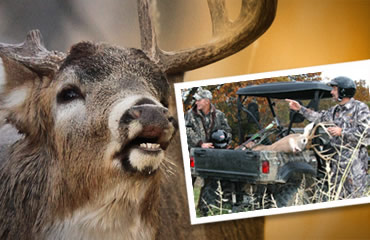If you live in whitetail country anywhere in the northern two thirds of the country you’re probably at or very close to the peak of the whitetail rut right now.
This can be a very exciting time to hunt. It can also be a very frustrating one.
Some folks prefer the early season because bucks are much more at ease, hanging close to home and often following something of a routine, moving from feeding to bedding in the morning, and bedding to feeding in the afternoon.
They’re also in bachelor groups so if you see one, you may see others. However, deer movement is usually limited to very early and very late in the day.
As the rut and cold weather approach, bucks are moving more, making them more vulnerable, but less predictable.
And that predictability declines with each passing day.
They may stick close to home at first, but once the first does come into estrus, the bucks start wandering. Deer that were seen in the same fields day after day suddenly show up on someone else’s fields one day and at another new location the next.
In order to be successful, the deer hunter must change tactics as the whitetails change theirs. When the bucks start roaming (seeking), you may be better off abandoning those stands overlooking food plots, and moving into travel corridors.
Sure, the does will still be on the feed, and the bucks will come looking, but it’s far more common for bucks to cruise the down-wind edges, just inside the woodline, scent-checking for hot does.
If they don’t get a hot whiff, they won’t stick their noses — or any other part of their body — out in the open. They’ll just move along.
If you live in areas dominated by agriculture or other open land, finding travel corridors is easy. Just look for thick growth, usually along stream and river channels, drainage ditches, windrows and fencelines, or narrow strips of woods connecting larger blocks. Cruising bucks are much more likely to follow these routes.
If you hunt in larger woodlands, study topo maps and look for topographic features like steep terrain or water bodies that funnel deer movement into narrow areas.
You should have scouted out these areas long before, and hung your stands well in advance of the rut. And you should have avoided these stands until now. It’s easy to burn out a stand simply by using it too often or too early.
Save your premium rut stands for the rut, and use them only when conditions are right, especially with regard to wind direction.
Keep in mind that how you approach your stand is at least as important as where you place it.
Whenever possible, try to make your approach as quiet and unobtrusive as possible. If you can use a boat to travel by waterway, that’s great. If you walk in, come from the downwind side and move slowly and quietly.
Occasionally you find locations that seem downright impossible to access without disturbing deer. If you do, your best approach may be the most direct approach. A human walking through the woods will always alarm deer. However, if the area receives ATV or Side-by-Side traffic on any kind of a regular basis — working livestock or tending crops or food plots — deer will become accustomed to the comings and goings of motorized vehicles.
You can ride in part way to your stand and walk only the last few hundred yards. It may be even better if you can get someone to drop you off near your stand. A vehicle passing through an area will cause less disturbance than one that comes and stays.
For more great tips, visit: Yamaha Outdoors Tips
– Photo Courtesy Bob Humphrey & Yamaha Outdoors
If you have a unique or special tip you’d like to share with Buckmasters fans, please email it to huntingtips@buckmasters.com and, if chosen, we will send you a cap signed by Jackie Bushman, along with a knife!
Read Recent Tip of the Week:
• Keep a Gear Checklist: If you’ve ever forgotten your flashlight, toilet paper, binos or even your gun, you’ll appreciate this handy checklist!




.png)